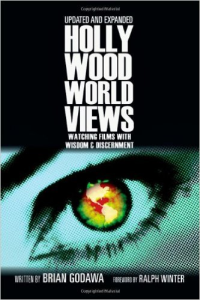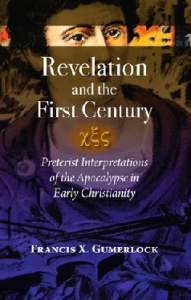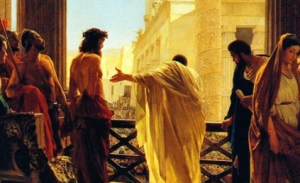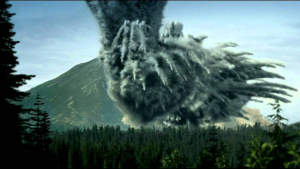Kenneth L. Gentry Jr.'s Blog, page 108
August 17, 2015
CULTURE, MOVIES, AND POSTMILLENNIALISM
 PMT 2015-099 by Kenneth L. Gentry, Jr.
PMT 2015-099 by Kenneth L. Gentry, Jr.
Postmillennialism believes in cultural engagement. In fact, it necessarily does so, and it does so as a transformationist approach to culture. That is, we believe that fallen culture must not only be challenged by the gospel and God’s word, but must be transformed by the power of God working through his people.
Modern American culture is greatly impacted by Hollywood movies and therefore by the Hollywood worldviews. Since movies are very much on people’s minds today, we as postmillennialists must recognize the power of story, the power of movies to affect our culture. And to do so, we must be able to discern, critique, and rebut the fallen worldviews presented in most movies today.
Perhaps the premiere analyst of Hollywood’s worldviews is Reformed, postmillennial, Christian apologist, screen writer, and author, Brian Godawa. His book Hollywood Worldviews: Watching Movies with Wisdom and Discernment is a must-have book for the alert Christian today.
In Hollywood Worldviews Godawa guides you through the place of redemption in film, the tricks screenwriters use to communicate their message of redemption, and the mental and spiritual discipline required for watching movies. This book helps you enter a dialogue with Hollywood that leads to a happier ending, one that keeps you aware of your culture and awake to your faith.
Redeeming Pop Culture
by T. M. Moore
Why is it important for us not to ignore the culture around us?
How can we engage, influence, and advance pop culture, and
how can we put popular forms to good use in God’s kingdom?
Moore urges us neither to flee from popular culture nor to immerse ourselves in it blindly.
See more study materials at: www.KennethGentry.com
His ten chapters are:
Sex, Violence, & Profanity
Stories & Mythology
Redemption
Existentialism
Postmodernism
Other Worldviews
Jesus
Christianity
Faith
Spiritual Warfare
The church I pastor is sponsoring a two-day “Hollywood Worldviews and the Bible” seminar with Brian Godawa on Friday and Saturday, September 18–19 in Greer, SC. Godawa will be presenting five lectures on important worldview themes in movies. He will be illustrating his points with brief clips from popular films. I have seen him present his seminar on three occasions and have always come away with a greater appreciation of the challenge before us.
Greatness of the Great Commission
(by Ken Gentry)
An insightful analysis of the full implications of the great commission.
Impacts postmillennialism as well as the whole Christian worldview.
See more study materials at: www.KennethGentry.com
His lectures will be:
Hollywood Worldviews (1) (Friday, Sept. 18, 7:00 pm
Hollywood Worldviews (2) (Friday, Sept. 18, 8:15 pm
Kiss, Kiss, Bang, Bang: Sex and Violence in the Movies (Saturday, Sept. 19, 9:30 am)
Beyond Entertainment: Redemption in the Movies (Saturday, Sept. 19, 11:00 am)
Horror as a Biblical Genre (Saturday, Sept. 19, 1:00 pm)
If you live anywhere near Greenville, SC, I encourage you to come. His presentations are enlightening, challenging, and encouraging. Our church is:
Living Hope Presbyterian Church
318 Hillcrest Dr.
Greer, SC 29651
See our website: LivingHopeSC.com









August 14, 2015
GUMERLOCK’S “REVELATION AND THE FIRST CENTURY”
 PMT 2014-098 by Kenneth L. Gentry, Jr.
PMT 2014-098 by Kenneth L. Gentry, Jr.
The preterist approach to Revelation holds that Revelation is to be understood as already fulfilled in the first century. Consequently, it has a strong historical interest.
Ironically though, many critics of the preterist approach to Revelation attempt to discredit it on an historical basis. They argue such things as:
“Preterism goes against the witness of the very early church” (Mal Couch).
“Alcazar, a [17th century] Spanish Jesuit, started the idea that the Apostle John . . . was writing about what was happening in his own day, and that his Antichrist was probably the Emperor Nero or some other early persecutor” (Duncan McDougall).
Before Jerusalem Fell Lecture
DVD by Ken Gentry
A summary of the evidence for Revelation’s early date.
Helpful, succinct introduction to Revelation’s pre-AD 70 composition.
See more study materials at: www.KennethGentry.com
How should the evangelical preterist respond? We must point out that preterism is found early in Christian history. And when we respond thus, we should consult Latin scholar and historical theologian Francis X. Gumerlock. Dr. Gumerlock has established himself as a credible proponent of preterism and an able defender of its historical bearing.
In this article I will provide a brief introduction to his important 2012 book: Revelation and the First Century: Preterist Interpretations of the Apocalypse in Early Christianity. I highly recommend this book for both your historical encouragement and your apologetic defense of preterism in today’s futurist environment.
As Latin scholar and historical theologian Gumerlock is well-equipped to engage the question raised. In his eighteen chapters (plus an Introduction and Conclusion), he ably closes the mouths of those who complain about the unhistorical nature of preterist exegesis.
In his first chapter he engages one of the most important issues in the debate: the early date of Revelation. He cites evidence from ancient writings that demonstrate that “there were at least ten different traditions favoring a date of the book of Revelation before 70 A.D.” (p. 24).
And in doing so he cites modern scholars who have noted this. For instance, he cites Kym Smith’s book Redating the Revelation (2001) who, according to Gumerlock, “conjectured that John wrote Revelation about 62 A.D.” (p. 33).
Later chapters deal with such issues as John’s exile by Nero (ch. 2), the tribulation in the first century (ch. 3), as well as Revelation passages pointing to Titus (ch. 5), the Roman siege of Jerusalem (ch. 6), Nero’s fatal wound in Rev 13 (ch. 10), the number 666 as pointing to Nero (ch. 11), and much, much more.
Before Jerusalem Fell
(by Ken Gentry)
Doctoral dissertation defending a pre-AD 70 date for Revelation’s writing.
Thoroughly covers internal evidence from Revelation, external evidence from history,
and objections to the early date by scholars.
See more study materials at: www.KennethGentry.com
For anyone interested in preterism, and especially preterism regarding the Book of Revelation, this is a must-have book. I cannot commend it more highly than I do. Gumerlock is your one-stop-shopping for evidence for preterism among the early church fathers. You should buy this book today. If not today, then tomorrow. But if you put it off to the third day, you are a procrastinator who probably did not get a birthmark until you were four years old.









August 12, 2015
POSTMILLENNIAL FAILURE TO ENGAGE CULTURE?
 PMT 2015-087 by Kenneth L. Gentry, Jr.
PMT 2015-087 by Kenneth L. Gentry, Jr.
A PostmillennialismToday reader is concerned that he sees postmillennialists withdrawing from culture rather than engaging it. Here is his question:
J.W. writes:
“I appreciate and have enjoyed much of your work. In fact, it was largely due to Edwards, you, and a few others that I saw postmillennialism as the midst rationally biblical option. That actually drove me into one of the most liberal cities in the US, but I find many PMers to be fleeing cultural engagement and implantation as much if not more than others. Why do you suppose that is a characteristic of many PMers but that I seem to be understanding it differently?”
Gentry replies:
I don’t know if this is actually the case. And if it is, I don’t know why it would be thus. All I could figure is that this would be an example of what Rushdoony called “intellectual schizophrenia”: the holding of one view and the operating in terms of an opposing view. What is your specific evidence of postmill retreat from cultural engagement?
Teaching for a Change
(by Norman De Jong)
Calls Christians to a biblical philosophy of education that deals with human nature, revealed truth,
and a child’s need to be transformed.
See more study materials at: www.KennethGentry.com
J.W. responds:
“Thanks! I need to read a little more Rushdoony because many I know that are followers of his work seem to be some of the same ones that advocate for and practically work toward creating a parallel Christian society rather than going in and influencing current systems. An example is the public school system. It seems many pressure for Christian disengagement while bemoaning the fruit of a system we’re disengaging from.
It just seems that postmillennialism is the only fire fighter equipped to run into the burning building of culture, and instead we simply busy ourselves with attempting to just build a new building while the current culture building burns to the ground. I don’t know, I could be way off with the practical realty of it all….”
Gentry concludes:
Now I see what leads you to surmise a postmillennial retreat from culture. Actually I believe you are mistaken in your reading of the situation. And your focus on Christian schooling exposes what I believe to be your error. Let me just briefly respond to that particular concern.
The idea of establishing Christian schools is not an example of cultural disinterest or disengagement. Rather it is specific focus on the enormous problem that faces us in education. I believe that establishing and promoting Christian schools is in fact an important and necessary response to rebellious human culture.
I would like to provide two reasons why I believe many Christians promote Christian schools, and why all Christians should do so.
First, many Christians promote Christian schools in order to provide a Christian education for their children right now. We only have young children for a brief time, and since we only have a short time to educate them and the education system is getting radically worse, Christians want to seek the best for their children.
Wall of Misconception: Separation of Church and State
(by Peter Lillback)
Examines our nation’s historic understanding of and the founding fathers
intention in the relationship of our Constitution to matters of faith, ethics, and morals,
taking into account the historical and biblical context as well as
the concept s relation to today’s culture.
See more study materials at: www.KennethGentry.com
Second, those supporting Christian schooling are not attempting merely to establish a parallel system of education, in order to provide more options. Rather, serious Christian-school advocates are seeking to establish a system with the long term goal of displacing the government funded, secularistic system. We need to be training our future leaders (our children) now. And we need to be training them in terms of the Christian worldview.
Thus, the Christian school movement has postmillennial implications (even if most of them are premillennial!) Christian schooling is a long-term strategy to renew our culture, with near-term responsibility for our children.








August 10, 2015
IS MATT 23:39 A PROBLEM FOR PRETERISM?
 PMT 2015-096 by Kenneth L. Gentry, Jr.
PMT 2015-096 by Kenneth L. Gentry, Jr.
Matt23:39 often confuses evangelicals who are considering the preteristic approach of postmillennialism. It seems to state that Israel will one day be converted, and only then will the great tribulation begin (according to the order of verses following Matt 23:39). That verse reads:
“For I say to you, from now on you shall not see Me until you say, ‘Blessed is He who comes in the name of the Lord!’”
But this statement does not suppose a future conversion of Israel that precedes the great tribulation. I do believe Israel will one day be converted to Christ. After all, I am a postmillennialist who believes that we are to “disciple all the nations” (Matt 28:19). And that we are to confidently trust that “if I be lifted up I will draw all men to myself” (John 12:32). And Israel is certainly one of the nations. In fact, Rom 11:25 is a powerful NT statement to this end.
So then, is the Lord’s statement in Matt 23:39 teaching that Israel will be converted before the great tribulation? I do not believe this is the case.
In this regard note the following quick observations:
First, the word “for” (Gk., gar ) connects this statement with the preceding context. The preceding context is one of unrelenting denunciation, ending with judgment. The “for” must introduce something other than a spiritual praise of Christ by the Jews, for such a sudden statement in this passage would be wholly unexpected.
Olivet Discourse Made Easy
(by Ken Gentry)
Verse-by-verse analysis of Christ’s teaching on Jerusalem’s destruction in Matt 24
See more study materials at: www.KennethGentry.com
The passage is dominated by the seven woes of Christ against the scribes and Pharisees, who were prominent leaders in Israel. And toward the end of the Lord’s denunciation, and just before Matt 23:39, he declares:
“Therefore, behold, I am sending you prophets and wise men and scribes; some of them you will kill and crucify, and some of them you will scourge in your synagogues, and persecute from city to city, so that upon you may fall the guilt of all the righteous blood shed on earth, from the blood of righteous Abel to the blood of Zechariah, the son of Berechiah, whom you murdered between the temple and the altar” (Matt 23:34–35).
And after this he laments:
“Jerusalem, Jerusalem, who kills the prophets and stones those who are sent to her! How often I wanted to gather your children together, the way a hen gathers her chicks under her wings, and you were unwilling. Behold, your house is being left to you desolate!” (Matt 23:37–38).
These strong statements do not sound like a lead-in to Israel’s salvation. And especially when we read the judgment upon the temple and Jerusalem in the Olivet Discourse that follows.
Second, the phrase “from now on” (Gk., ap arti) is indefinite, holding out only an uncertain possibility. Thus, it does not declare as a matter of fact: “you will see me.” Jesus is denouncing the Jews, not offering them hope. He is about to be crucified by them amidst Israel’s strong rejection and their affirmation of Caesar: “As a result of this Pilate made efforts to release Him, but the Jews cried out saying, ‘If you release this Man, you are no friend of Caesar; everyone who makes himself out to be a king opposes Caesar’” (John 19:12).
Matthew 24 Debate: Past or Future?
(DVD by Ken Gentry and Thomas Ice)
Two hour public debate between on the Olivet Discourse.
See more study materials at: www.KennethGentry.com
Third, the praise here (“blessed is he who comes”) is not necessarily a voluntary, loving, humble praise. It could well be a constrained praise. The Scripture often speaks of the sinner’s constrained praise of God. We see this, for instance, in:
“For this reason also, God highly exalted Him, and bestowed on Him the name which is above every name, so that at the name of Jesus every knee will bow, of those who are in heaven and on earth and under the earth, and that every tongue will confess that Jesus Christ is Lord, to the glory of God the Father” (Phil 2:10–11).
“For it is written, ‘As I live, says the Lord, every knee shall bow to me, and every tongue shall give praise to God’” (Rom 14:11).
Consequently, given the context, the praise to be uttered by the Jews appears to be constrained and with reluctance. He is speaking to those Jews in that day. They will soon see him in chains and then mounted on a cross to die. They will soon strike him and spit upon him. But he is not the feeble man they believe him to be. He will turn the tables on them in AD 70.








August 6, 2015
SATAN AND HIS ANGELS IN REV 12:4
 PMT 2015-095 by Kenneth L. Gentry, Jr.
PMT 2015-095 by Kenneth L. Gentry, Jr.
A reader asks:
Dr. Gentry, I just got done watching your Revelation series on DVD. I just had a few questions.
I noticed you didn’t really touch much on Rev 12:4, and I’ve always been curious as to the meaning of that verse. A lot of people use it to say that when Satan rebelled he took a third of the angels with him. But that verse doesn’t seem to be talking about his rebellion at all, but rather his defeat during Christ’s earthly ministry. If that’s the case, then are there any other verse that talk about a “third of the angels”? Or is Scripture actually silent about that?
My reply:
Thanks for watching my lectures on Revelation in the “Survey of the Book of Revelation” DVD set. Obviously I could not deal with every verse and every topic in the twenty-four lectures, but this is a good question and deserves a reply. Please consider the following comments on Rev 12:4. Clearly, the dragon is Satan, as John makes clear in Rev 12:9. But what does he mean we he speaks of his “tail” which “swept away a third of the stars of heaven and threw them to the earth”?
Most commentators recognize that John draws his imagery here from Dan 8:10 where the “small horn” of the ram “grew up to the host of heaven and caused some of the host and some of the stars to fall to the earth.”
How does John intend us to understand Satan’s sweeping down these stars? We know that he often re-interprets and re-applies his OT sources. For instance, G. K. Beale states: “Though Dan. 8:10 first had application to Antiochus, John now applies it in an escalated way to the devilish power behind Antiochus.” Craig Keener argues here that “Revelation rarely takes over Jewish symbols … even those from the divinely inspired Old Testament, without reapplying them.”
So then: What is John doing here as he re-applies Daniel’s reference?
Survey of the Book of Revelation
(DVDs by Ken Gentry)
Twenty-four careful, down-to-earth lectures provide a basic introduction to and survey of the entire Book of Revelation. Professionally produced lectures of 30-35 minutes length.
See more study materials at: www.KennethGentry.com
The action so vividly recorded here states that the dragon’s tail “swept away” a third of “the stars of heaven” (12:4a). The word translated “swept away” is surei, which means to “drag, pull, draw, drag away.” This word is used of Christians being dragged to prison (Acts 8:3) by Paul’s exercising the authority given to him from the high priest (9:1–2). It is also employed where Christians are being hauled before “city authorities” in Thessalonica (Ac 17:6). Thus, it shows the exertion of power or the exercise of authority over an object or person.
Here in 12:4 the verb is a pres. act. indic. (lit., “drags”) functioning as a historical present in order to vividly portray this past action. After these “stars” are dragged from heaven, the dragon “threw them to the earth” (12:4). The word translated “threw” is ebalen, an aor. act. indic. signifying a past action. But again: what is going on here? What do these stars and this Satanic action represent? I believe the following captures John’s point.
This does not speak of Satan’s original fall near the beginning of history. The immediate context of this chapter clearly shows the dragon is engaging in persecution, not only of the woman (ideal Israel, Rev 12:6, 13, 15), but her male child (Jesus Christ, 12:4b) and her other offspring (the first-century Jewish Christians,12:17). According to the NT, Satan involves his lesser cohorts, the fallen angels, in prompting persecution (Lk 22:3; Rev 2:9–10; 13:1–2, 6–7). Here Satan’s action in Rev 12:4 ironically anticipates the divine counterpart in 12:9: “the great dragon was thrown down, the serpent of old who is called the devil and Satan, who deceives the whole world; he was thrown down to the earth, and his angels were thrown down with him.”
As Gordon Fee expresses it: 12:4 “serves here primarily as an identity marker, thereby setting up for Satan’s being cast out of heaven.” When we compare 12:3 and 12:9 we understand John’s ironic point to be: though Satan himself throws his angelic forces to the earth to afflict God’s people, God will throw Satan and his angels out of heaven in utter defeat.
The stars represent angels (supernatural spiritual beings). Perhaps the majority of scholars hold that these stars picture angels. Stars can represent angels in Scripture (Jdg 5:20; Job 38:7; cp. 1 En. 18:13–16; 86:1–6; 90:24). In Rev 9:1 the star that falls from heaven appears to be “the angel of the abyss” (Satan). As noted above, 12:4a anticipates 12:7–10, presenting the irony involved in Satan’s fall.
Blessed Is He Who Reads: A Primer on the Book of Revelation
By Larry E. Ball
A basic survey of Revelation from the preterist perspective.
It sees John as focusing on the destruction of Jerusalem and the temple in AD 70.
See more study materials at: www.KennethGentry.com
The reference to the “third of the stars” continues the pattern of partial, one-third destruction recently transpiring under the seven trumpets (Rev 8:7–12, 15, 18). Satan is focusing a sizeable portion of his demonic hordes on his current evil work in the first century. Satan’s power is great, but not as great as God’s, for God’s power is truly “almighty” (1:8; 4:8; 11:17; 15:3; 16:7, 14; 19:6, 15; 21:22). Though Satan’s “craft and power are great” and he is “armed with cruel hate,” to exercise his power in the important field of battle before him requires that he marshal an army of demons (12:9; Mt 25:41; Lk 11:18).
That Satan throws his angelic forces “to the earth” indicates that he rapidly moves his troops to the field of battle to confront Christ and his people. The phrase “to the earth,” should be translated “into the Land” (eis t n g n), i.e., of Israel. The focus of the Satan’s full-scale assault is during Jesus’ ministry and comes especially to a head in his crucifixion. Israel is small in comparison to the rest of the world (“you were the fewest of all peoples,” Dt 7:7) which Satan seeks to dominate (cf. Dt 32:17; Job 1:7; 2:1; Ac 26:18; 1Co 10:20; 2Co 4:4). Nevertheless, she is the central battleground for Satan’s assault on the kingdom of God.
Hence we see an enormous outburst of demonic activity at Christ’s coming: his casting out demons is a sign that “the kingdom of God has come upon you” (Mt 12:28//). Because of this, at the very beginning of his ministry the Holy Spirit leads him into the wilderness to be tested by the devil (Mk 1:12//) and during his ministry “he cast out many demons” (Mt 8:16; 10:8; Mk 1:34; 6:13). As he establishes his kingdom the Lord authorizes his disciples to cast out demons (Mt 10:8//). Near the end of his ministry; the devil inspires Judas to betray him (Jn 13:2, 27).
Thus, Rev 12:4 is not speaking of Satan’s original fall into sin, but is picturing his own evil action in casting his demonic hordes into battle against Christ. And Christ’s victory ends up having Satan himself thrown out of heaven. This all comes to a dramatic conclusion in the context of AD 70 where his forces are defeated in their effort to destroy Christ’s people.








August 5, 2015
WHERE DO WE GO AT DEATH?
PMT 2015-094 by Kenneth L. Gentry, Jr.
Partick W. writes:
“One thing I’m a little confused about is the ultimate end of history. Does man remain on earth when Christ returns? After Christ has put all enemies under his feet and handed over the kingdom to the Father, does heaven and hell “merge” and man remains on earth for a lack of better words while Christ is present physically (assuming also still in some sense everywhere present because he’s God). I’m so confused as I feel like I always hear by and large from Christians is to just go to heaven and it seems many believe the present earth to be destroyed. Or is there something else beyond earth/heaven?”
Ken Gentry responds:
Basically, I believe that when we die now (in history) we go to heaven — as did the disciples, the thief on the cross, and Paul the apostle:
To the thief, Jesus said in Luke 23:43: “Truly I say to you, today you shall be with Me in Paradise.”
To the disciples the Lord promised in John 14:2–3: “In My Father’s house are many dwelling places; if it were not so, I would have told you; for I go to prepare a place for you. If I go and prepare a place for you, I will come again and receive you to Myself, that where I am, there you may be also.” (This “coming” refers to his coming to each of them at their physical deaths, otherwise they would not enter into glory until the end of history.)
Paul stated in Phil 1:21–24: “For to me, to live is Christ and to die is gain. But if I am to live on in the flesh, this will mean fruitful labor for me; and I do not know which to choose. But I am hard-pressed from both directions, having the desire to depart and be with Christ, for that is very much better; yet to remain on in the flesh is more necessary for your sake.”
He Shall Have Dominion
(paperback by Kenneth Gentry)
A classic, thorough explanation and defense of postmillennialism (600 pages)
See more study materials at: www.KennethGentry.com
But at the end of history when the Lord returns we will be given our physical, resurrected, final bodies that are incorruptible: “Now I say this, brethren, that flesh and blood cannot inherit the kingdom of God; nor does the perishable inherit the imperishable. Behold, I tell you a mystery; we will not all sleep, but we will all be changed, in a moment, in the twinkling of an eye, at the last trumpet; for the trumpet will sound, and the dead will be raised imperishable, and we will be changed. For this perishable must put on the imperishable, and this mortal must put on immortality” (1 Cor 15:50-53).
This transformation of our bodies will be on “the last day”: “This is the will of Him who sent Me, that of all that He has given Me I lose nothing, but raise it up on the last day. (John 6:39). These bodies are designed for a physical realm rather than a spiritual realm. After all, God created angels as spirits: “Are they not all ministering spirits, sent out to render service for the sake of those who will inherit salvation?” (Heb. 1:14). Whereas God created us a physical creatures designed for a physical world: “Then the LORD God formed man of dust from the ground, and breathed into his nostrils the breath of life; and man became a living being” (Gen. 2:7).
So on “the last day” God will re-fashion the earth and we will enter the consummate, final new earth: “But the day of the Lord will come like a thief, in which the heavens will pass away with a roar and the elements will be destroyed with intense heat, and the earth and its works will be burned up. Since all these things are to be destroyed in this way, what sort of people ought you to be in holy conduct and godliness, looking for and hastening the coming of the day of God, because of which the heavens will be destroyed by burning, and the elements will melt with intense heat! But according to His promise we are looking for new heavens and a new earth, in which righteousness dwells” (2 Pet 3:10–13).
Thus, we now enjoy the spiritual preparation for the consummate new creation: we are spiritually new creations in Christ: “Therefore if anyone is in Christ, he is a new creature; the old things passed away; behold, new things have come” (2 Cor 5:17). And we have been spiritually resurrected: “God, being rich in mercy, because of His great love with which He loved us, even when we were dead in our transgressions, made us alive together with Christ (by grace you have been saved), and raised us up with Him, and seated us with Him in the heavenly places in Christ Jesus” (Eph 2:4–6; cp. John 5:25). But then on the last day we will be physically resurrected for the physical new creation.
Bringing Heaven Down to Earth
(by Nathan Bierma)
A Reformed study of heaven. By taking a new look at the biblical picture of heaven,
Nathan Bierma shows readers how heaven can be a relevant, meaningful,
inspiring engine of Christian faith and kingdom service.
See more study materials at: www.KennethGentry.com
This theological perspective is called the “Now / But Not Yet” approach. That is, we now spiritually enjoy — by way of anticipation — the future full, glorious reality to come. Jesus links these two realities for us in John 5:25–29:
“Truly, truly, I say to you, an hour is coming and now is, when the dead will hear the voice of the Son of God, and those who hear will live. For just as the Father has life in Himself, even so He gave to the Son also to have life in Himself; and He gave Him authority to execute judgment, because He is the Son of Man. Do not marvel at this; for an hour is coming, in which all who are in the tombs will hear His voice, and will come forth; those who did the good deeds to a resurrection of life, those who committed the evil deeds to a resurrection of judgment.”








August 3, 2015
HIDE US FROM THE WRATH OF THE LAMB
 PMT 2015-093 by Kenneth L. Gentry, Jr.
PMT 2015-093 by Kenneth L. Gentry, Jr.
In my last article I noted the moving mountains in Revelation and how they do not speak of a literal tectonic movements. That passage is easily applied to the Roman warfare method during the Jewish War. But similarly, the calling upon the mountains to fall also speaks of the circumstances of the Jewish War.
Rev 6:17 reads:
“They said to the mountains and to the rocks, ‘Fall on us and hide us from the presence of Him who sits on the throne, and from the wrath of the Lamb; for the great day of their wrath has come, and who is able to stand?’”
Men hiding in caves is easy enough to understand in a literal fashion. But we need to realize how important a feature this becomes in the Jewish War. Its appearance in Revelation is not a simple matter of local color; it was an issue of great significance. Josephus records many instances showing how the caves and caverns were used by the Jews in attempts to escape the wrath of the Roman armies, for example:
Christian Theistic Ethics
29 Gentry class lectures on mp3 USB
Formal Christ College course on Christian Theistic Ethics.
Demonstrates theonomic underpinnings of Christian ethics.
See more study materials at: www.KennethGentry.com
“And on this day it was that the Romans slew all the multitude that appeared openly; but on the following days they searched the hiding-places, and fell upon those that were under ground, and in the caverns” (War 3:7:36).
“So now the last hope which supported the tyrants, and that crew of robbers who were with them, was in the caves and caverns under ground; whither, if they could once fly, they did not expect to be searched for; but endeavored, that after the whole city should be destroyed, and the Romans gone away, they might come out again, and escape from them. This was no better than a dream of theirs; for they were not able to lie hid either from God or from the Romans. However, they depended on these under-ground subterfuges” (War 6:7:3).
“This Simon, during the siege of Jerusalem, was in the upper city; but when the Roman army was gotten within the walls, and were laying the city waste, he then took the most faithful of his friends with him, and among them some that were stone-cutters, with those iron tools which belonged to their occupation, and as great a quantity of provisions as would suffice them for a long time, and let himself and all them down into a certain subterraneous cavern that was not visible above ground” (War 7:2:1).
Ecclesiology Course
25 Gentry class lectures on USB
Full Christ College course lectures on the doctrine of the Church.
Includes sizeable study of the sacraments.
See more study materials at: www.KennethGentry.com
Contrary to Jewish hopes, the mountains were not immovable, nor were the caverns impenetrable. As Revelation 6:16–17 warns: “They said to the mountains and to the rocks, ‘Fall on us and hide us from the presence of Him who sits on the throne, and from the wrath of the Lamb; for the great day of their wrath has come; and who is able to stand?’” Their escape efforts fail, as Josephus notes:
“They did not expect to be searched for; but endeavored, that after the whole city should be destroyed, and the Romans gone away, they might come out again, and escape from them. This was no better than a dream of theirs; for they were not able to lie hid either from God or from the Romans” (War 6:7:3).
“The Romans slew some of them, some they carried captives, and others they made a search for under ground, and when they found where they were, they broke up the ground and slew all they met with” (War 6:9:4).
“Now, so far as had been digged of old, they went onward along it without disturbance; but where they met with solid earth, they dug a mine under ground, and this in hopes that they should be able to proceed so far as to rise from under ground in a safe place, and by that means escape. But when they came to make the experiment, they were disappointed of their hope; for the miners could make but small progress, and that with difficulty also; insomuch that their provisions, though they distributed them by measure, began to fail them” (War 7:2:1).
They cannot hide from the presence of God nor the wrath of the Lamb, for none is “able to stand”(Rev. 6:17). John’s prophecy parallels Jesus’ earlier one in Luke 23:28-30: “Jesus turning to them said, ‘Daughters of Jerusalem, stop weeping for Me, but weep for yourselves and for your children. For behold, the days are coming when they will say, “Blessed are the barren, and the wombs that never bore, and the breasts that never nursed.” Then they will begin to say to the mountains, “Fall on us,” and to the hills, “Cover us.”’”
Once again, John’s prophecy finds adequate and relevant fulfillment in the first century Jewish War.








July 31, 2015
THE MOVING MOUNTAINS IN REVELATION
 PMT 2015-092 by Kenneth L. Gentry, Jr.
PMT 2015-092 by Kenneth L. Gentry, Jr.
In Rev 6 one of the more dramatic images involves the shaking of all the mountains as God’s wrath falls. This is sometimes used as evidence against preterism and a first-century fulfillment of Rev. But does it undermine preterism? I think not. And here is why.
“And the sky was split apart like a scroll when it is rolled up; and every mountain and island were moved out of their places. And the kings of the earth and the great men and the commanders and the rich and the strong and every slave and free man, hid themselves in the caves and among the rocks of the mountains” (Rev. 6:14–15).
How shall we explain the moving of every mountain? What is the historical reality behind this apocalyptic imagery?
Survey of the Book of Revelation
(DVDs by Ken Gentry)
Twenty-four careful, down-to-earth lectures provide a basic introduction to and survey of the entire Book of Revelation. Professionally produced lectures of 30-35 minutes length.
See more study materials at: www.KennethGentry.com
To understand the imagery we must consider the first century circumstances involved in the Roman assault upon Israel. Much of Israel’s terrain around her important cities provided significant natural defenses serving as impediments to marauding armies. This is especially true for the armed forces of the highly ordered and mechanized Roman armies. Josephus frequently mentions the mountain impediments facing the Romans:
“Agrippa observed that even the affairs of the Romans were likely to be in danger, while such an immense multitude of their enemies had seized upon the mountains round about” (War 2:19:3).
“Now Jotapata is almost all of it built on a precipice, having on all the other sides of it every way valleys immensely deep and steep, insomuch that those who would look down would have their sight fail them before it reaches to the bottom. It is only to be come at on the north side, where the utmost part of the city is built on the mountain, as it ends obliquely at a plain. This mountain Josephus had encompassed with a wall when he fortified the city, that its top might not be capable of being seized upon by the enemies. The city is covered all round with other mountains, and can no way be seen till a man comes just upon it. And this was the strong situation of Jotapata.
Therefore, in order to try how he might overcome the natural strength of the place, as well as the bold defense of the Jews, made a resolution to prosecute the siege with vigor. To that end he called the commanders that were under him to a council of war, and consulted with them which way the assault might be managed to the best advantage” (War 3:7:7–8).
“A great multitude prevented their approach, and came out of Jericho, and fled to those mountainous parts that lay over against Jerusalem, while that part which was left behind was in a great measure destroyed; they also found the city desolate. It is situated in a plain; but a naked and barren mountain, of a very great length, hangs over it, which extends itself to the land about Scythopolis northward, but as far as the country of Sodom, and the utmost limits of the lake Asphaltiris, southward. This mountain is all of it very uneven and uninhabited, by reason of its barrenness” (War 4:8:2).
1 John: Salvation, Heresy, Assurance
20 mp3 sermons on USB by Ken Gentry
First John is a much neglected epistle that deals with crucial issues explains salvation,
warns against heresy, and demonstrates the assurance of salvation.
See more study materials at: www.KennethGentry.com
A remarkable feature of Roman siege warfare lies behind the image of the mountains being moved. The Roman legions included demolition crews who labored to overcome the mountainous defenses facing them. The moving of every mountain out of their places symbolizes their successful work, as recorded by Josephus.
“Now Vespasian was very desirous of demolishing Jotapata, for he had gotten intelligence that the greatest part of the enemy had retired thither, and that it was, on other accounts, a place of great security to them. Accordingly, he sent both foot-men and horsemen to level the road, which was mountainous and rocky, not without difficulty to be traveled over by footmen, but absolutely impracticable for horsemen. Now these workmen accomplished what they were about in four days’ time, and opened a broad way for the army” (War 3:7:3).
“But Titus, intending to pitch his camp nearer to the city than Scopus, placed as many of his choice horsemen and footmen as he thought sufficient opposite to the Jews, to prevent their sallying out upon them, while he gave orders for the whole army to level the distance, as far as the wall of the city. So they threw down all the hedges and walls which the inhabitants had made about their gardens and groves of trees, and cut down all the fruit trees that lay between them and the wall of the city, and filled up all the hollow places and the chasms, and demolished the rocky precipices with iron instruments; and thereby made all the place level from Scopus to Herod’s monuments, which adjoined to the pool called the Serpent’s Pool” (War 5:3:2).
These dramatic historical occurrences in Josephus fit well with the dramatic, symbolic prophecies of John. And given the near-term expectation established by John and the absurdity of a direct literal interpretation, nothing hinders the reasonable interpreter from recognizing these events as the historical fulfillments in view.








July 29, 2015
WHAT IS THE “SYNAGOGUE OF SATAN”?
 In Rev 2:9 (cp. 3:9) we read Jesus saying to Pergamum: “‘I know your tribulation and your poverty (but you are rich), and the blasphemy by those who say they are Jews and are not, but are a synagogue of Satan.” Evangelical commentator Ramsey Michaels argues that the false Jews of “the synagogue of Satan” are actually non-Jews, just like the “false apostles” in the letter to the church at Ephesus were not actual apostles. In fact, this is the majority view among Rev commentators.
In Rev 2:9 (cp. 3:9) we read Jesus saying to Pergamum: “‘I know your tribulation and your poverty (but you are rich), and the blasphemy by those who say they are Jews and are not, but are a synagogue of Satan.” Evangelical commentator Ramsey Michaels argues that the false Jews of “the synagogue of Satan” are actually non-Jews, just like the “false apostles” in the letter to the church at Ephesus were not actual apostles. In fact, this is the majority view among Rev commentators.
Against this position I would urge the following
First, why would anyone in the first-century Roman empire other than a racial Jew claim to be a Jew? The Jews were detested in the Roman world:
1. They were driven out of Rome under Claudius for causing riots;
2. Tacitus claims of the Jews “the rest of the world they confront with the hatred reserved for enemies” and are “a most lasivious people” (Histories, 5);
3. According to Suetonius (Tiberius, 36), Tiberius “abolished foreign cults at Rome, particulary the Egyptian and Jewish, forcing all citizens who had embraced these superstitious faiths to burn their religious vestments and other accessories. Jews of military age were removed to unhealthy regions, in the pretext of drafting them into the army; the others of the same race or of similar beliefs were expelled from the city and threatened with slavery if they defied the order.”
Before Jerusalem Fell
(by Ken Gentry)
Doctoral dissertation defending a pre-AD 70 date for Revelation’s writing.
Thoroughly covers internal evidence from Revelation, external evidence from history,
and objections to the early date by scholars.
See more study materials at: www.KennethGentry.com
4. They ultimately were attacked and destroyed by the Roman armies in AD 70 (and since Michaels holds that Revelation was written after AD 70, this would seem to greatly weaken his observation).
Second, the word “synagogue” is a distinctively Jewish place of worship. It is often used in the New Testament of the Jewish meeting house in the first century (e.g., Matt 4:23; 9:35; 23:34; Mark 1:39; 4:22; 6:2; Luke 4:15–20; 6:6; 8:41; 13:10; John 6:59; 9:22; 18:20; Acts 6:9; 9:2; 13:5; 14:1; etc.). The word “synagogue” occurs sixty-eight times in the New Testament and is always used of the Jewish place of worship.
Third, the whole character of Revelation seems to emphasize that Christianity is the true Israel of God, and would suggest John’s put down of Judaism among ethnic, literal Jews:
1. The 144,000 from the 12 tribes surely speaks of Christianity under Jewish imagery (and probably refers to the Jewish Christians in Israel). They are the perfect number, who are set over against those who “pierced” the Messiah (Rev. 1:7).
2. The New Jerusalem is from heaven and seems to replace the old (Rev. 11; Rev. 21; cp. Gal. 4:20ff; Heb. 12:18ff). We should note that the Epistle to the Hebrews similarly contrasts Christianity with the old Jewish order about to be shaken — as made with hands (Heb. 12:27, 28 cp. Heb. 9:11, 24).
3. Christ’s marriage to the bride from heaven, the new Jerusalem, seems to imply the putting away of God’s old wife, the old Jerusalem. She is capitally punished for spiritual adultery so that the new bride might lawfully be taken..
Fourth, the “synagogue of Satan” fits well with John’s imagery in his Gospel, where he records Jesus’s charge that the leaders of Israel are “of your father the devil” (John 8:44). John’s Gospel has a well-known strain of antagonism against “the Jews” (the leadership of Israel?). In fact, many liberal theologians deem it to be anti-Semitic. This would fit well with John’s Revelation and its declaration that Jews have become a “synagogue of Satan.”
Blame It on the Brain?
Sub-title: Distinguishing Chemical Imbalances, Brain Disorders, and Disobedience
by Edward T. Welch
Depression, Attention Deficit Disorder, Alcoholism, Homosexuality.
Research suggests that more and more behaviors are caused by brain function or dysfunction.
But is it ever legitimate to blame misbehavior on the brain?
How can I know whether my brain made me do it?
See more study materials at: www.KennethGentry.com
Fifth, P. W. L. Walker’s excellent Jesus and the Holy City (Eerdmans, 1996) shows how, for instance, Matthew and Luke set up Christianity as the true Israel over against the Jewish claims. In a book as obviously Jewish as Revelation (Hebraic grammar, old covenant images, Old Testament allusions, etc.) we should expect an even more obvious attempt to present Christianity as the true Israel of God.
Thus, “the synagogue of Satan” attended by those who “call themselves Jews” surely refers to organized Judaism. And in the two diaspora cities of Pergamum and Smyrna, it undoubtedly refers to actual assemblies of the Jews.









July 27, 2015
AMILLENNIAL PESSIMISM
 PMT 2015-090 by Kenneth L. Gentry, Jr.
PMT 2015-090 by Kenneth L. Gentry, Jr.
Amillennialists often complain that postmillennialists wrongly categorize them as “pessimistic.” They generally reject this evaluation for two reasons: (1) It is negative sounding in itself. And (2) it overlooks the fact that they believe that ultimately Christ and his people win the victory at the end of history. Still other amillennialists deny this designation because they call themselves “optimistic amillennialists.”
What do postmillennialists mean by categorizing amillennialism as “pessimistic”? Is the charge legitimate. I believe it is.
Obviously all evangelical eschatological perspectives are ultimately optimistic — even dispensationalists who make a very nice living from books on cultural decline, despair, and doom. After all, Christ does lead his people to victory in saving them from their sins in history, resurrecting them from the dead at the end of history, and establishing them in righteousness in eternity. These issues are not debated among evangelicals: Christianity is of glorious, eternal consequence. But neither are these observations relevant to the debate between the millennial views.
Three Views on the Millennium and Beyond
(ed. by Darrell Bock)
Presents three views on the millennium: progressive dispensationalist, amillennialist, and reconstructionist postmillennialist viewpoints. Includes separate responses to each view
See more study materials at: www.KennethGentry.com
Historically amillennialism has tended to be pessimistic in terms of the question of widespread, long-lasting cultural success for the Christian faith in time and on earth. That is, regarding these matters we should note:
First, as a system of gospel proclamation amillennialism teaches that the gospel of Christ will not exercise any majority influence in the world before Christ’s return. They allow that Christianity may enjoy flashes of revival and spurts of growth (e.g., the Reformation and the Great Awakening). Yet, by its very nature the amillennial system cannot allow that Christianity will become the dominant feature of human society and culture. Otherwise, it would actually be postmillennialism.
Second, as a system of historical understanding amillennialism, in fact, holds that the Bible teaches there are prophetically determined, irresistible trends downward toward chaos in the outworking and development of history. It is true that some amillennialists such as Jay E. Adams understand the great tribulation in the Olivet Discourse as referring (correctly) to the Jewish War and the AD 70 destruction of the temple. Yet their overall eschatological system necessarily demands a prophetically-determined collapse of society in history, as we can see in the writings of Jay Adams. Otherwise, it would actually be postmillennialism.
Amillennialism v. Postmillennialism Debate
(DVD by Gentry and Gaffin)
Formal, public debate between Dr. Richard Gaffin (Westminster Theological Seminary)
and Kenneth Gentry at the Van Til Conference in Maryland.
See more study materials at: www.KennethGentry.com
Third, as a system for the promotion of Christian discipleship amillennialism dissuades the Church from anticipating and laboring for wide-scale success in influencing the world for Christ during this age. It affirms the duty for churches to disciple converts, but it does not believe there will be enough converts to affect the direction of history. Otherwise, it would actually be postmillennialism. Regarding the question of so-called “optimistic amillennialists,” it seems to me that the verses an amillennialist would use to underscore his optimism are those that endorse a postmillennial perspective. Unless, of course, he is optimistic on grounds other than direct biblical revelation. Therefore, he should come out of the closet and be a postmillennialist.








Kenneth L. Gentry Jr.'s Blog
- Kenneth L. Gentry Jr.'s profile
- 85 followers




